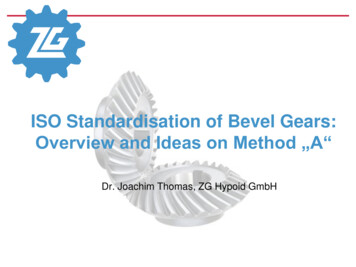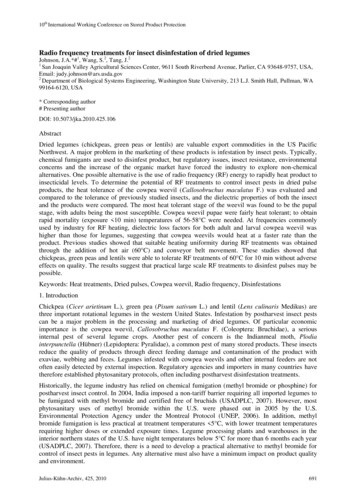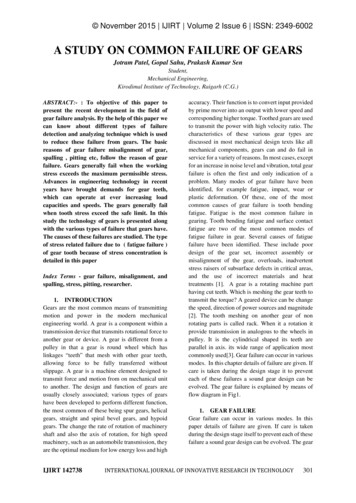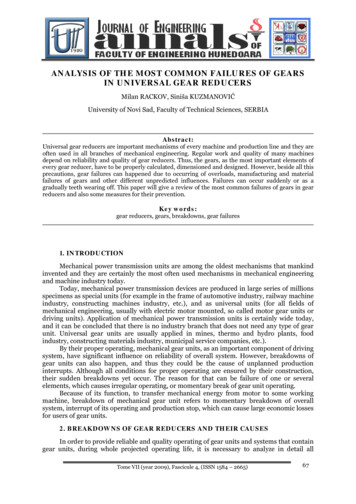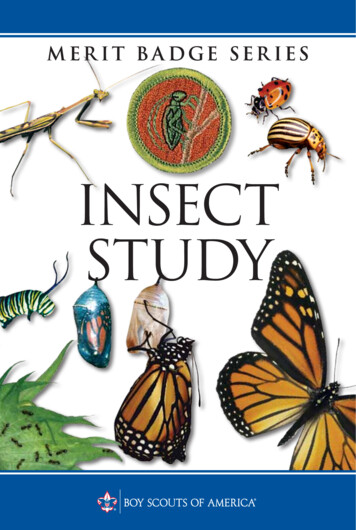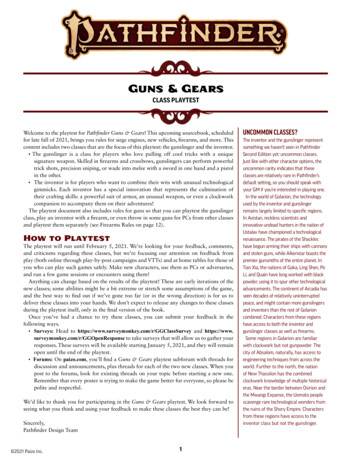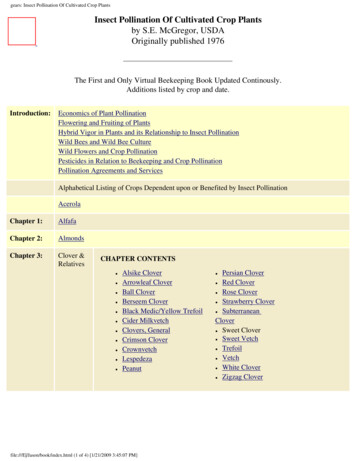
Transcription
gears: Insect Pollination Of Cultivated Crop PlantsInsect Pollination Of Cultivated Crop Plantsby S.E. McGregor, USDAOriginally published 1976The First and Only Virtual Beekeeping Book Updated Continously.Additions listed by crop and date.Introduction:Economics of Plant PollinationFlowering and Fruiting of PlantsHybrid Vigor in Plants and its Relationship to Insect PollinationWild Bees and Wild Bee CultureWild Flowers and Crop PollinationPesticides in Relation to Beekeeping and Crop PollinationPollination Agreements and ServicesAlphabetical Listing of Crops Dependent upon or Benefited by Insect PollinationAcerolaChapter 1:AlfafaChapter 2:AlmondsChapter 3:Clover &RelativesCHAPTER CONTENTS Alsike CloverArrowleaf CloverBall CloverBerseem CloverBlack Medic/Yellow TrefoilCider MilkvetchClovers, GeneralCrimson CloverCrownvetchLespedezaPeanutfile:///E /Jason/book/index.html (1 of 4) [1/21/2009 3:45:07 PM]Persian Clover Red Clover Rose Clover Strawberry Clover SubterraneanClover Sweet Clover Sweet Vetch Trefoil Vetch White Clover Zigzag Clover
gears: Insect Pollination Of Cultivated Crop PlantsChapter 4:Legumes&RelativesChapter Contents BeansBroad Beans and Field BeansCowpeaKidneyvetchKudzuLima Beans Chapter 5:TreeFruits &Nuts &ExoticFruits &NutsLubinesMung Bean, Green or GoldenGramPigeonpeaSainfoinScarlet Runner BeanSoybeanChapter Contents CoconutCrabappleDurianDateFigLitchi file:///E /Jason/book/index.html (2 of 4) [1/21/2009 3:45:07 PM]MacadamiaMangoMangosteenNeemOil PalmOlivePapawPapayaPassionfruitPeach and NectarinePearPersimmonPlum and PrunePomegranateQuinceRambutan
gears: Insect Pollination Of Cultivated Crop PlantsChapter 6:CommonVegetablesfor Seed& FruitChapter Contents Chapter 7:SmallFruits &BramblesArtichoke and CardoonAsparagusBalsam PearBeetBroccoliBrussels ryChiveCole CropsCorianderCucumber and GherkinsEggplantEndive LeekLettuceMuskmelonOkraOnionParsnipPepper, GreenPumpkin and SquashRadishTomatoTurnip and RutabagaVegetable SpongeWatermelon and CirtonWelsh, or Spring OnionWhite Flowered GourdWhite GourdChapter Contents BlackberryBlueberryChinese GooseberryCoffeeCranberryCurrantGooseberryGrapes, Raisins and CurrentsGuavafile:///E /Jason/book/index.html (3 of 4) [1/21/2009 3:45:07 PM] HuckleberryJujube, Tsao, or Chinese DateKenafKiwiKolanutLoquatRaspberryStrawberry
gears: Insect Pollination Of Cultivated Crop PlantsChapter 8:Misc.GardenPlants,Foods,Flowers& HerbsChapter Contents Chapter 9:CropPlants andExoticPlantsChervilDillDrug PlantsFennelHerbsLavenderParsleyChapter Contents AniseBlack Pepper, White imoyaCloveCottonCrotalariaFeijoaFlaxMamey SapoteMustardfile:///E /Jason/book/index.html (4 of 4) [1/21/2009 3:45:07 PM] NigerNutmeg and MacePimento or AllspicePyrethrumRapeSafflowerSesameSisal and ite Sapote
file:///E /Jason/book/econ.htmlINSECT POLLINATION OF CULTIVATED CROPPLANTSBy S. E. McGREGORApiculturist, retired, Agricultural Research ServiceWestern Region, Tucson, Ariz.ECONOMICS OF PLANT POLLINATIONWorldwide, more than 3,000 plant species have been used as food, only 300 of which are now widelygrown, and only 12 of which furnish nearly 90 percent of the world's food. These 12 include the grains:rice, wheat, maize (corn), sorghums, millets, rye, and barley, and potatoes, sweet potatoes, cassavas or1maniocs, bananas, and coconuts (Thurston 1969). The grains are wind-pollinated or self-pollinated,coconuts are partially wind-pollinated and partially insect pollinated, and the others are propagatedasexually or develop parthenocarpically. However, more than two-thirds of the world's population is inSoutheast Asia where the staple diet is rice. Superficially, it appears that insect-pollination has little effecton the world's food supply - possibly no more than 1 percent.Within the United States, which accounts for only about 6 percent of the world's population, about 286million acres were cultivated in 1969. About 180 million acres were devoted to the wind pollinated or selfpollinated crops, primarily barley, corn, oats, rice, rye, sorghums and wheat, grass hay crops, sugar beets,sugar cane, potatoes, sweet potatoes, and tobacco. About 60 million acres were devoted to crops that mayreceive some benefit from insect pollination but are largely self-pollinating (beans, cotton, flax, peanuts,peas, and soybeans). About 40 million acres were devoted to hay crops produced from bee-pollinatedseeds (alfalfa, clovers, lespedezas). About 6 million acres were devoted to producing fruits, vegetables,and nuts--most of which are dependent upon insect pollination. Table 1 lists the cultivated crop plants,discussed herein, that are dependent upon or benefited by insect pollination. These plants provide about 15percent of our diet.The animal products we consume contribute about an equal amount to our diet. These include beef, pork,poultry, lamb, and dairy products--derived one way or another from insect-pollinated legumes such asalfalfa, clover, lespedeza, and trefoil.More than half of the world's diet of fats and oils comes from oilseeds--coconuts, cotton, oil palm, olives,peanuts, rape, soybeans, and sunflower (Guidry 1964). Many of these plants are dependent upon orbenefited by insect pollination. When these sources, the animal and plant products, are considered, itappears that perhaps one-third of our total diet is dependent, directly or indirectly, upon insect-pollinatedplants.file:///E /Jason/book/econ.html (1 of 9) [1/21/2009 3:45:10 PM]
file:///E /Jason/book/econ.htmlIn addition, the insect-pollinated legumes have the ability to collect nitrogen from the air, store it in theroots, and ultimately leave it to enrich the soil for other plants. Without this beneficial effect, soils notfertilized by processed minerals would soon be depleted and become economically unproductive.Another value of pollination lies in its effect on quality and efficiency of crop production. Inadequatepollination can result not only in reduced yields but also in delayed yield and a high percentage of culls orinferior fruits. In this connection, Gates (1917) warned the grower that, "he may fertilize, and cultivate thesoil, prune, thin and spray the trees, in a word, he may do all of those things which modern practiceadvocates, yet without his pollinating agents, chief among which are the honey bees, to transfer the pollenfrom the stamens to the pistil of the blooms, his crop may fail."With ample pollination, the grower may also be able to set his blooms before frost can damage them, sethis crop before insects attack, and harvest ahead of inclement weather. Earliness of set is an oftenoverlooked but important phase in the crop economy.The value of pollination on the succeeding generation of crops is also frequently overlooked. The value ofhybrid seed is not reflected until the subsequent generation. Vigor of sprouting and emerging from the soilis often a vital factor in the plant's early survival. Other responses to hybrid vigor include earliness ofdevelopment, plant health,and greater production of fruit or seed.1 The year in italic after the author's name refers to Literature Cited at the end of each major section.Signs of Inadequate PollinationThere are numerous ways a grower, with little or no intimate knowledge of the life and habits ofpollinating insects, can measure the effictiveness of the polllination of his crop. He would be wise todetermine these ways in connection with the particular[page 2, 3, 4]compact clusters of fruits or seeds, and uniform set. For example, adequate pollination is indicated by twoor more muskmelons near the crown or base of the vine, or a majority of the apples developing from theking, or primary flower, at the tip of the cluster. In a watermelon field, adequate pollination would beindicated by a high percentage of melons in the number 1 class, that is, symmetrical, completely developedthroughout, and of satisfactory weight.Ecological RelationshipsThe value of insect pollination, the only type of pollination upon which man can exert much influence, isnot limited to the cultivated crops. Bohart (1952*)2 pointed out that the most drastic effect of the absenceof pollinating insects would be in uncultivated areas, where, as a result, most soil-holding and soilenriching plants would die out. He also mentioned that springtime would be bleak indeed without the usualgay flowers.file:///E /Jason/book/econ.html (2 of 9) [1/21/2009 3:45:10 PM]
file:///E /Jason/book/econ.htmlBaker and Hurd (1968) also recognized this important ecological relationship, for they stated that "insectpollination is still extremely important among the fortes of the grasslands, in the shrub and herb layer ofthe temperate forest and in the desert. It remains undiminished in the tropics."A simultaneous warning of disaster was recently issued because of our disregard of the importance ofpollination. Abelson (1971) stated, "We have developed extraordinarily productive farm crops, butmonoculture and the use of limited strains of plants makes the food supply vulnerable to plant enemiessuch as the southern corn leaf blight." He reminded us that plants are constantly involved in complexchemical warfare not only with pests but also with each other. The slightest weakening may give theenemy the advantage. Likewise, Harlan (1971) reminded us that "The post-modern era has seenspectacular increases in yield, and a virtual genetic wipe-out, with whole continents planted to one or a fewrelated populations. These narrow genetic bases and loss of gene pools are invitations to disaster." Crosspollination can be one means of preventing such a disaster. This vulnerability to disaster was enlargedupon by Horsfall et al. (1972), who cited such examples as the chestnut blight at the turn of the century,the Bengal famine of India in 1943, and the Irish famine of the 1840's.The somewhat related warning by Tinker (1971) that one plant species in 10,000 or 20,000 species facesextinction is indicative of the growing problem of a continual adequate food supply of the pollinators. Thatsuch changes are actually having an impact on pollinators now was pointed out by Oertel (1966). Hemaintained certain colonies of honey bees on scales at Baton Rouge, La., and recorded the gain or loss inweight throughout the season from 1929 to 1963. His data (table 2) showed that over the years the weightof the colonies decreased from an average gain of 7 pounds to an average loss of 24 pounds during theperiod September to November. This loss, he deduced, was related to weed sprays, better pasture care thatin general reduced the fall honey flow from goldenrod, a reduction in cultivated crops attractive to bees,along with increased plantings of soybeans that are relatively unattractive, and urbanization. Similarreports from commercial beekeepers across the continent are common. Oertel (1966) stated that lack of anadequate fall crop of honey caused the colonies to be less productive the following spring. According toWearne et al. (1970), this decreased pasturage was also associated with bee losses.Hawthorn and Pollard (1954,* p. 56) related this detrimental effect on colony condition to our costs ofvegetables when they stated:In recent years there has been an increasing accumulation of data to indicate that seed yields of insect-pollinatedcrops may often be lower than they need be, not because of climate, soil, or cultural factors, but simply because thepopulation of certain insects is low.With a planting of many acres there may not be enough insects such as honey bees to visit the millions of flowersnormally present. Even native pollinating insects may be somewhat scarce because the very activity of preparingand cultivating such a large area of land may have destroyed some of their nesting places. Finally, to control someinjurious insect the operator may have sprayed the entire planting with an insecticide which has killed manybeneficial insects as well as the harmful ones.Such action is reflected in the economy of beekeeping, as pointed out by Crane (1972) who stated:file:///E /Jason/book/econ.html (3 of 9) [1/21/2009 3:45:10 PM]
file:///E /Jason/book/econ.htmlIn many parts of the world beekeeping hangs in the balance and the scales are tipped against the bees and thebeekeepers. . . the very change in land use which now seems to be bringing about the end of beekeeping may lead toits recognition as an essential part of agriculture, because of its importance for crop production.TABLE 2.--Average gains ( ) or losses ( - ), in pounds, for colonies (of honey bees) on scales for 5-yearperiods between 1929 and 1963, Baton Rouge, La.1YearsJulyAugustSeptemberOctoberNovember1929-33 14-1-16 32- 91934-38 11-5- 7.6 17.6- 61939-43 13-4.4- 9 18.4- 81944-48 38-4- 8.5 2- 61949-5310 382 11- 7.6 2.5-1954-58 11-11.4-11.2- 5.3- 81959-63 21-11-14- 4- 61 Source: Oertel (1966).2 A net gain of 50 pounds in August 1950 was responsible for this exception to the usual August losses. An averagenet gain of 312 pounds was obtained in 1950: net gains were recorded each month from March to October.Bruner (1966) studied the purely business aspect of vegetable production in northwest Mexico. He notedthat the weakness of the "Mexican dictatorial-paternalistic method of farm operation" precludedobtainment of the best technically trained men and new ideas. Bruner considered the lack of proper"saturation-pollination" by bees and protection of beneficial insects from pesticides to be two majorreasons for low agricultural production in certain areas. Some larger operations in our country tend to fallinto a similar category.Farms are likely to continue to increase in size because of increased efficiency of operations. Blosserfile:///E /Jason/book/econ.html (4 of 9) [1/21/2009 3:45:10 PM]
file:///E /Jason/book/econ.html(1960) showed that the average cost of crop production on 640-acre farms was 9.5 to 15.1 percent less thanon 160-acre farms that were producing the same crops.3Swift reported on the impact of a changed pest control program on the insect pollinators and indirectly onthe community. Because of the DDT residue in milk, the California Pest Control Program was changed toinclude numerous other insecticides, which were much more toxic to honey bees than DDT. The impact ofthis change was disastrous to the honey bee industry, with 40,000 to 80,000 colonies killed annually. Theindirect result was that in 1968 the almond growers, who depend upon honey bees for the pollination oftheir almond crop, were short at least 26,000 colonies. Swift pointed out that this change to protect themilk had an unanticipated adverse effect on beekeeping, an industry not associated with the dairy industry,and this in turn affected the almond producers, who were still less associated. Swift further pointed out thatCalifornia crops, valued at 300 million, were dependent upon insect pollination, primarily by honey bees.The value of insect-pollinated crops in the United States was reported by Metcalf and Flint (1962) to be 4.5 billion. Crops dependent upon insect pollination were valued by Levin (1967) at 1 billion, withadditional crops benefited by bee pollination valued at approximately 6 billion. The honey and beeswaxproduced were valued at about 45 million. In other words, honey bee colonies are worth roughly 100times as much to the community as they are to the beekeeper.The aesthetic value of pollination to ornamentals, wild flowers, and forest and range plants in terms ofbeauty of the landscape is recognized for specific plants (Alcorn et al. 1962, Grant and Grant 1965,McGregor et al. 1962, and Meeuse 1961*) and in general (Kerner 1896-97*, and Knuth 1906-09*), but itcannot be measured. Nor can we measure the related ecological value in terms of seeds, fruits, and nutsproduced, which are used as food for various forms of wildlife, but this value, too, is doubtlessconsiderable.Pollinators other than honey bees are also extremely valuable although their value is difficult to estimate.Within recent years, a few insect species have been managed by man for their pollination service. Bohart(1962*) estimated that the value of the wild bee industry was well over 1 million per year in terms ofexpenditures and benefits. It had expanded considerably by 1972. No doubt numerous other unmanagedand generally unrecognized wild bees exceed Bohart's estimate. He dealt largely with the gregariousleafcutter bee (Megachile pacifica Panzer),4 and the equally gregarious alkali bee (Nomia melanderiCockerell). Bumble bees are excellent, although generally unmanageable, pollinators (Holm 1966).Unfortunately, in many intensively cultivated areas, they have largely been eliminated.2The year in italic followed by an asterisk indicates that the publication is cited numerous times, but the completecitation is given only once in the General Literature Cited, p. 3823SWIFT, J. E. UNEXPECTED EFFECTS FROM SUBSTITUTE PEST CONTROL PROGRAMS.Presented at a symposium on The Biological Impact of Pesticides in the Environment, Oreg. State Univ., Corvallis,Aug. 18-20,1969,16 pp. 1969. (Mimeographed.)file:///E /Jason/book/econ.html (5 of 9) [1/21/2009 3:45:10 PM]
file:///E /Jason/book/econ.html4Formerly known as M. rotundata Fabr. (Holm and Skou 1972).Commercial Pollination PotentialsIn a study of the beekeeping industry, Anderson (1969) concluded that the decline in the number ofcolonies of honey bees from 5.9 million in 1947 to 4.8 in 1966 was attributable to the low rate of return onthe invested capital. Some beekeepers have tried to increase production by moving their colonies from onehoney flow to another, a practice started as early as 1895 (Zierner 1932). At that time, apiaries inCalifornia were moved by wagon from the desert sage and wild buckwheat to the cultivated lima beanfields. Today, thousands of colonies are moved hundreds of miles each year to several different floralsources. Anderson reported that others have tried to supplement their honey sales through the placement oftheir colonies in fields for pollination, but few could indicate that a profit was made.If the need for insect pollination is increasing, one would assume that the number of colonies of honeybees should also be increasing to help meet this demand. Such is not the case. The number of colonies inthe United States has been decreasing steadily for more than two decades. Furthermore, in contrast toearlier recommendations that every farm keep a few colonies of bees (Tyler and Haseman 1915), thecolonies are no longer present on almost every farm. They have either shifted to the suburbs, where theyare operated by hobbyists who have short workweek employment, or they are operated by large-scalecommercial beekeepers. This situation has disturbed the more or less even distribution of pollinators acrossthe countryside, and even created a serious deficiency in some areas.In some instances, this lack of an adequate supply is made up by the beekeeper renting colonies to thegrower. An estimated 1 million colonies are rented for pollination of crops in the United States annually(there are no concrete figures on the number of such colonies). In some instances, the rental fees are nogreater than those of five decades ago. There are several reasons for such low fees. There is almost noorganized use of bees for pollination. Each beekeeper sets his own price. Sometimes the bees are suppliedalmost as a favor in exchange for apiary locations throughout the year, or for favorable consideration inrelation to pesticides applied near the bees. The beekeeper may be hesitant to ask for higher fees for fearanother beekeeper might undercut his price or move into his "territory."Unfortunately, when the beekeeper operates the colonies at a low pollination fee, he tries to make up hisfee elsewhere--a practice that may not be to the best interest of the grower. An inadequate number ofcolonies for maximum pollination may be supplied, the colonies may not contain the desired population ofworker bees, or they may not be appropriately managed or distributed throughout the field to be pollinated.A population of bees necessary for maximum set of fruit or seeds on the crop may be far greater than thelocation will support for honey production or colony maintenance.There appears to be a potential market for many more properly maintained and managed colonies of honeybees for pollination of present and anticipated crops than can be mobilized. However, the beekeeper isreluctant to go to the extra expense and labor of moving his colonies into an overstocked area unless hecan collect an adequate fee for his trouble and have some assurance that the colonies will not be damagedfile:///E /Jason/book/econ.html (6 of 9) [1/21/2009 3:45:10 PM]
file:///E /Jason/book/econ.htmlby pesticides. He frequently finds himself in no position to bargain for these considerations. This points upthe need for an organized pollination service staffed by experts acquainted with the needs and problems ofboth the grower and the beekeeper and capable of bargaining fairly for both. (See "Pollination Agreementsand Services.")Literature CitedABELSON, P. H.1971. OPPORTUNITIES IN PLANT SCIENCE. Science 172(3989): Editorial page, no page number.ALCORN, S. M., MCGREGOR, S. E., and OLIN, G.1962. POLLINATION REQUIREMENTS OF THE ORGAN-PIPE CACTUS. Cactus and Succulent Jour.34: 134 - 138.ANDERSON, E. D.1969. AN APPRAISAL OF THE BEEKEEPING INDUSTRY. U.S. Dept. Agr., Agr. Res. Serv. ARS 42150,38 pp.BAKER, H. G., and HURD, P. D., JR.1968. INTRAFLORAL ECOLOGY. Ann. Rev. Ent. 13: 385-414.BLOSSER, R. H.1960 SIZE OF FARM AFFECTS CROP COSTS. Ohio Farm and Home Sci. 45(6): 92--93.BRUNER, J. .M1966. MANAGEMENT--A STRATEGIC AGRICULTURAL RESOURCE. Ariz. Business Bul. 13(10):10 - 18.CRANE, E.1972. BEEKEEPING IN THE BALANCE.[Editorial.] Bee World 53: 3 - 4.GATES, B. N.1917. HONEY BEES IN RELATION TO HORTICULTURE. Mass. Hort. Soc. Trans. 1: 71-88.GRANT, V., and GRANT, K. A.1965. FLOWER POLLINATION IN THE PHLOX FAMILY. 180 pp. Columbia University Press, NewYork and London.GUIDRY, N. P.1964. GRAPHIC SUMMARY OF WORLD AGRICULTURE. U. S. Dept. Agr. Misc. Pub. 705, 64 pp.HARLAN, J. R.file:///E /Jason/book/econ.html (7 of 9) [1/21/2009 3:45:10 PM]
file:///E /Jason/book/econ.html1971. GENETICS OF DISASTER. Agron. Abs., Ann. Mtg. Amer. Soc. Agron., p. 7.HOLM, S. N.1966. THE UTILIZATION AND MANAGEMENT OF BUMBLEBEES FOR RED CLOVER ANDALFALFA SEED PRODUCTION. Ann. Rev. Ent. 11: 155 - 182.and SKOU, J. P.1972. STUDIES ON TRAPPING, NESTING AND REARING OF SOME MEGACHILE SPP.,(HYMENOPTERA, MEGACHILIDAE) AND ON THEIR PARASITES IN DENMARK. Ent. Scand. 3:169-180.HORSFALL, J. G., BRANDON, G. E., BROWN, W. L., and others.1972. GENETIC VULNERABILITY OF MAJOR CROPS. 307 pp. Natl. Acad. Sci., Washington, D. C.LEVIN M. D.1967. POLLINATION. In Beekeeping in the United States, U. S. Dept. Agr., Agr. Handb. 335, pp. 77-85.MCGREGOR, S. E., ALCORN, S. M., and OLIN, G.1962. POLLINATION AND POLLINATING AGENTS OF THE SAGUARO. Ecology 43: 259-267.METCALF, C. L., and FLINT, W. P.1962. DESTRUCTIVE AND USEFUL INSECTS. Ed. 4, 1087 pp. McGraw-Hill Book CO. Inc., NewYork and London.OERTEL, E.1966. OUR CHANGING AGRICULTURE REQUIRES CHANGES IN BEEKEEPING.Amer. Bee Jour.106: 401-408.THURSTON, H. D.1969. TROPICAL AGRICULTURE- A KEY TO THE WORLD FOOD CRISIS. Bioscience 19: 29-34.TINKER, J.1971. ONE FLOWER IN 10 FACES EXTINCTION. New Scientist and Sci. Jour. 50 (751): 408-413.TYLER, E. E., and HASEMAN, L.1915. FARM BEE-KEEPING. Mo. Agr. Expt. Sta. Bul. 138, 40 pp.WEARNE, R. A., BERGMAN, P., GIBBS, L. C., and others.1970. BEE LOSSES--THE IMPACT ON POLLINATION--HONEY PRODUCTION. U.S. Dept. Agr.Ext. Serv., 12 pp.ZIERNER, C. M.file:///E /Jason/book/econ.html (8 of 9) [1/21/2009 3:45:10 PM]
file:///E /Jason/book/econ.html1932. MIGRATORY BEEKEEPERS OF SOUTHERN CALIFORNIA. Geog. Rev. 22: 260 - 269.file:///E /Jason/book/econ.html (9 of 9) [1/21/2009 3:45:10 PM]
file:///E /Jason/book/flower.htmlFLOWERING AND FRUITING OF PLANTSSome basic knowledge of the structure of seed-forming plants, and particularly of the flower, is essentialto visualize the marvelous contrivances and unique requirements for the union of the sex cells whichgive rise to the viable seed. Although each has a basic pattern, their intricate and diverse modificationspermit plant life in some form to survive over much of the surface of our globe.The PlantRoots, stems, leaves, and even flower parts are sometimes concerned with asexual or vegetativereproduction. Particular sections of different plants are frequently preferable for vegetative reproduction,for example, the runners or stolons of the strawberry, the tuber of the potato, the bulb of the onion, thecorm of the iris, the nodes or joints of the sugar cane, and the leaf of a violet. Reproduction in garlic isby bulbils, sometimes called cloves, that form in the flower head. Bulbils also form in the inflorescenceof some agaves.Asexual reproduction in plants has certain advantages. The asexual offspring of a plant, usually referredto as clones, are genetically identical. An example would be cuttings taken from a grapevine, rooted andused to create an entire orchard of a single clone. The plants would be uniform in appearance, vigor,flowering time, fruit ripening time, and fruit quality. Asexual reproduction can be made at any time,even before the plant is mature enough to produce seeds, or with plants such as the sweet potato or sugarcane that normally set no seed under our climatic conditions.Asexual reproduction has some disadvantages. If there is a degree of self-sterility in the parent plant, thiscannot be overcome by cross- pollination between the plants unless another compatible cultivar isinterplanted. The use of asexual parts is sometimes bulky or otherwise less convenient than the use ofseeds. Diseases and insects are more likely to be transferred on asexual parts than on seeds. Some plantscannot be easily or economically reproduced asexually.Some plants reproduce both asexually and sexually, and both types of reproduction have certainadvantages from the plant standpoint. Sexual reproduction, in which insects or other external agentssometimes play a part, concerns the development of seed in the flower. The external agent's contributiondepends upon construction of the flower and the compatibility of the flower with its own pollen.In sexual reproduction, cross-pollination can occur, leading to higher production or quality through morecomplete fertilization. It can also lead to hybrid vigor, or heterosis, from the crossing of two unlikeplants to produce a more vigorous one. Such mixing of genes may also enable future generations toadapt to different environmental conditions, insuring their survival, as they have apparently done in thepast (Leppik 1970a, b). Almost two centuries ago, after Knight (1799) had studied the effects of selffertilization in plants, he concluded that no plant can maintain itself with self-fertilization for anunlimited number of generations. In a figurative sense, it would seem as if Nature abhors selffile:///E /Jason/book/flower.html (1 of 16) [1/21/2009 3:45:13 PM]
file:///E /Jason/book/flower.htmlfertilization and constantly strives ingeniously to achieve cross-pollination within the species. Innumerous plants, selfing is permitted only after all efforts at cross-pollination have failed. Selfing is theplants final attempt to survive until favorable opportunity for crossing can occur. Again, figurativelyspeaking, Nature orders the plant: "Become fertilized, cross- fertilized if you can, self-fertilized if youmust."The FlowerThe flower has a simple basic pattern, but with seemingly infinite variations. Typically, the flower (fig.1) is composed of the sexual organs, protected by delicate colorful petals that form a tube or crownlikecorolla, and which in turn are supported and partially protected by the usually green, more durablesepals, collectively called the calyx. The calyx and corolla combined are referred to as the perianth.There may be leaflike bracts just below the sepals.The male part (or androecium) of the sexual organs are the stamens, which consist of the hairlikefilaments bearing the pollen-producing anthers on the extremities. At the appropriate time, these anthersdehisce or split open and disgorge the male element, the numerous microscopic and usually yellowgrains of pollen. The size of pollen grains varies from 4 to 6 microns for the little forget-me- not(Myosotis sylvatica Hoffm., family Boraginaceae) (Meeuse 1961*) to the relatively gigantic 350-microngrain of Cymbopetalum odoratissimum Rodr., family Annonaceae (Walker 1971), or the 2,550 by 3.7micron tubelike grain of the water-pollinated eel grass (Zostera marina L., family Naiadaceae)(Wodehouse 1935). The size of the majority of pollen grains is in the 25- to 50-micron range. (1 micron 0.001 mm).The shape and sculpturing of pollen grains is even more diverse, and their characteristics are used in theidentification of the plant source of the pollen (Wodehouse 1935, Zander 1935, 1937).The amount of pollen produced per flower varies from only 32 grains in the four-o'clock (Mirabilisjolapa L., family Nyctaginaceae) (Kerner 1897*, v. 4, p. 98), to several spoonfuls in the blossom of theAbyssinian banana (Musa ensete G. Mel., family Musaceae) (Pryal 1910).The female part (or gynoecium) of the flower is the pistil, consisting of the ovary with one to numerousovules and, extending from the ovary, the style with the receptive portion, the stigma, on or near the tip.The pistil may be composed of one or more carpels. The ovary produces the fruit and the ovules t
maniocs, bananas, and coconuts (Thurston 1969).1 The grains are wind-pollinated or self-pollinated, coconuts are partially wind-pollinated and partially insect pollinated, and the others are propagated asexually or develop parthenocarpically. However, more than two-thirds of the world's popul

